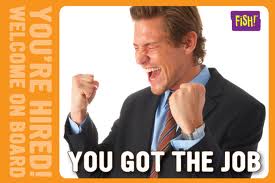
You'd be surprised, but only about one out of 10 of the technology executive clients I speak to have a built-out online identity - that is, they show up in more places than just LinkedIn. The time is past when a progressing executive can afford to be invisible on the Web. In fact, a built-out Web presence can serve as a critical competitive advantage, whether you are in a job search mode or not. The one thing to remember is:
EVERYONE GOOGLES EVERYONE!
This is even more true of recruiters and hiring authorities. In fact, the executive resume may well be one of the last pieces of marketing content they see, following the LinkedIn profile, FaceBook, Twitter, and whatever else they turn up in a Google search of your name.
This fact is actually good when you consider that you are able to present yourself and your career brand in full-color 3-D. Let's look at the sought-after candidate of the future:
- He doesn't just have a 100% complete LinkedIn profile, he takes advantage of everything LI can do. He adds a PowerPoint presentation to convey subject matter expertise or achievement. His Twitter feed on LI shows that he is in touch with what's going on in the industry and function. A video he embeds in his profile gives viewers a chance to see him in action and hear his voice. His Groups activity demonstrates once again that he is a player. He provides insightful Answers.
- She has a Twitter profile and a significant following of at least hundreds of interested followers. Her tweets are a record of her professional interests, expertise, and resource sharing.
- She skillfully blends professional and personal on her Facebook page, ensures that Timeline has a clean record of her comments, and puts up a profile on Monster's BeKnown.
- He uses Slideshare or Sliderocket to store PowerPoint presentations.
- He is on YouTube giving talks on his areas of subject matter expertise.
- She may have tasteful photos on Flickr that show more of her life, including travels, family, etc.
- He has profiles up on Jigsaw, ZoomInfo, and other similar sites.
- He has an about.me page with URLs to properties where he can be found online.
- She has her own personal website or blogsite where you can see her resume, testimonials, projects, leadership highlights, etc.
- She blogs regularly on professional issues and comments on other people's blogs.
Perhaps a Google of Bing search will also turn up entries from press releases, published materials, speaking engagements, etc.
It simply will no longer be enough to just have a resume if you are embarked on a job search or seeking advancement within your own organization. So begin now to build out your online identity so that a search will find on-brand content you want people to see. If you do so at the dawn of 2012, you will have an edge on the competition.




 The vast majority of employers and recruiters search LinkedIn before deciding whether to interview you. If you're conducting a job search, do you know how to optimize LinkedIn to your advantage? Here are a few ideas. Please add additional ones in comments!
The vast majority of employers and recruiters search LinkedIn before deciding whether to interview you. If you're conducting a job search, do you know how to optimize LinkedIn to your advantage? Here are a few ideas. Please add additional ones in comments!
